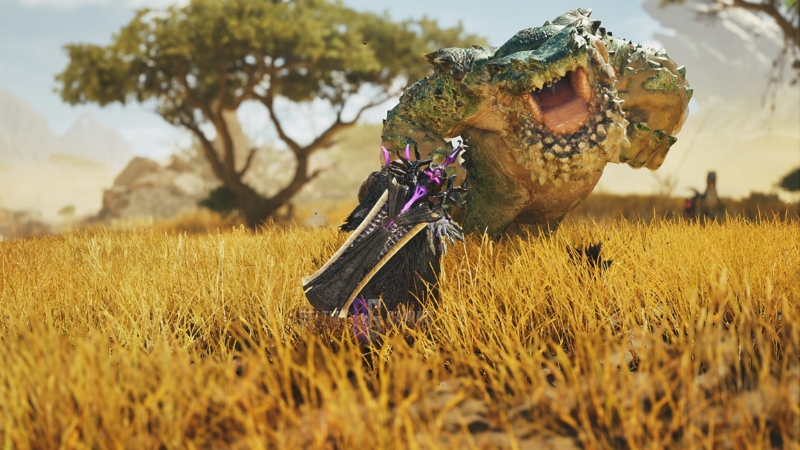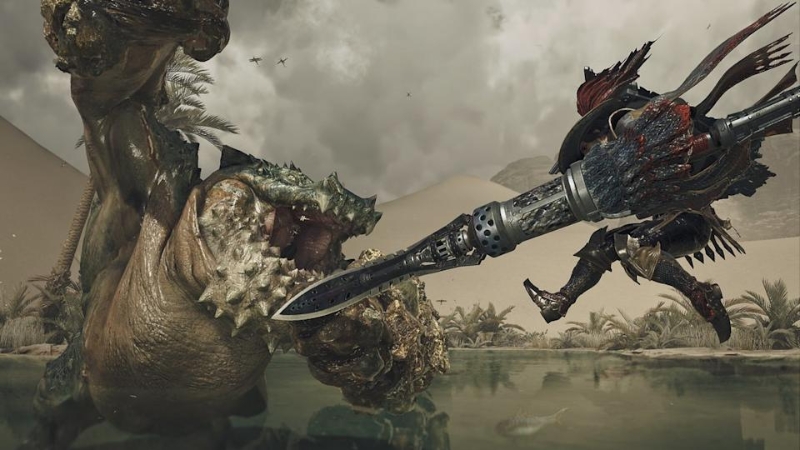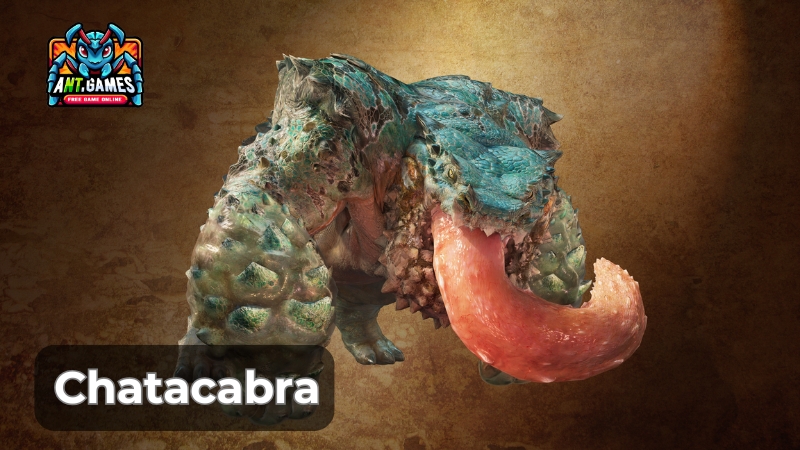In the vast, sun-bleached landscapes of Monster Hunter Wilds, the Chatacabra stands out as a unique threat among the game’s diverse roster of monsters. This Amphibian creature, marked by its shimmering turquoise hide and burly, ore-encrusted limbs, demands attention not only for its striking appearance but for its dynamic combat style.
Early encounters with the Chatacabra in the Windward Plains challenge hunters to adapt quickly, mastering evasion techniques and exploiting environmental opportunities. Despite being relatively accessible for new hunters, this monster’s unpredictable movements and sticky tongue attacks make it a memorable adversary for players of all skill levels. This guide provides an in-depth look at the Chatacabra’s traits, battle strategies, and lore, preparing you to take down this ferocious desert denizen.
Chatacabra’s Physical Characteristics
Before facing Chatacabra in the wild, it’s crucial to understand the features that make this monster both a physical powerhouse and a master of its environment.
- Size and Appearance: Chatacabra’s robust, ape-like frame mirrors the stature of Fanged Beasts like Rajang, with powerful forelimbs dominating its silhouette. Its body is clad in rigid turquoise scales accented by black patterns, and a spiky lower jaw evokes the ferocity of Deviljho. A long, muscular tongue coils within its maw, ready to lash out.
- Unique Features: The monster’s forelimbs are its defining trait, coated in sticky mucus-like saliva that allows it to affix stones and ores. This adaptation transforms its punches into devastating blows, tailored to the harsh desert environment of the Windward Plains.
Compared to other Amphibians like Tetsucabra, Chatacabra’s simian posture and ore-based attacks give it a unique edge, blending brute strength with environmental adaptability.

Chatacabra’s Behavior and Combat Abilities
To survive a clash with Chatacabra, it’s vital to anticipate how this cunning predator moves and strikes—its behavior and combat style reveal both its greatest threats and its exploitable weaknesses.
Behavior: Chatacabra is a territorial insectivore, preying on Bulaqchi in the Windward Plains. It uses its long tongue to snatch prey with precision. When threatened, it rubs its forelimbs on the ground to collect stones or ores, enhancing its attack power and armoring its limbs.
Combat Abilities:
- Tongue Whip: A long-range strike with its sticky tongue, sweeping across a wide arc. Dodge sideways to avoid.
- Forelimb Slam: Powerful punches with ore-coated arms, often chained into combos when enraged. Block or roll to evade.
- Charge Attack: A forward rush with jaws open, attempting to bite. Sidestep to create counter-attack opportunities.
Counters:
- Roll laterally to dodge tongue whips and charges, exploiting the recovery frames.
- Focus attacks on ore-covered arms to break them, stunning Chatacabra and exposing vulnerabilities.
- Trigger environmental traps like falling boulders to interrupt its attacks and deal significant damage.

Where to Encounter Chatacabra in the Game
Hunters eager to test their skills against Chatacabra will need to know where it lurks—and which quests offer the best opportunities to track it down and claim its valuable materials.
Locations: Chatacabra roams the Windward Plains, primarily in:
- Zone 8 (Wetlands)
- Zone 13 (Desert)
- Underground east of Zone 3 (its den, where it retreats when weakened)
Specific Quests:
- Slimy Situation: A Low Rank story quest in Chapter 1-1: Desert Trotters, introducing Chatacabra as a key target.
- High-Quality Materials: A High Rank side mission (HR10, post-Chapter 4-1: New Ecosystems) for farming Chatacabra Hide+.
- Event Quests: While not the focus, Chatacabra may appear in Festival of Accord: Blossomdance hunts, offering rewards like Blossomdance Tickets.
Encounter Table:
| Quest Name | Rank | Location | Conditions | Rewards |
| Slimy Situation | Low Rank | Windward Plains | Story quest, Chapter 1-1 | Chatacabra materials |
| High-Quality Materials | High Rank | Windward Plains | HR10, side mission | Chatacabra Hide+ |
| Event Quests (General) | High Rank | Windward Plains | During Blossomdance event | Blossomdance Tickets, gear |
As of April 29, 2025, no Arch-Tempered Chatacabra is confirmed; Title Update 1 features only Arch-Tempered Rey Dau.
Discover: 48 Monster in Monster Hunter Wilds
Combat Strategies for Defeating Chatacabra
Conquering Chatacabra demands more than raw strength—you’ll need the right weapons, tactics, and timing to exploit its weaknesses and turn the tide of battle.

Weaknesses
Knowing where Chatacabra is most vulnerable can make all the difference—here’s a breakdown of the elements and ailments that hit hardest.
| Type | Effectiveness |
| Thunder | ★★ (High) |
| Ice | ★ (Moderate) |
| Dragon | Resistant |
| Stun | ★★★ (High) |
| Paralysis | ★★★ (High) |
| Poison | ★★★ (High) |
| Sleep | ★★ (Moderate) |
| Blastblight | ★★ (Moderate) |
| Exhaust | ★★ (Moderate) |
Recommended Gear
- Weapons: Thunder-element weapons like the Thunder Long Sword or Charge Blade deal optimal damage. Blunt weapons (e.g., Hammer) excel at stunning via headshots.
- Armor: Prioritize Thunder resistance and skills like Evade Extender for dodging its sweeping attacks.
- Items: Max Potions, Mega Potions, Pitfall Traps, Shock Traps, Flash Pods, and Dung Pods (to repel other monsters).
Tactics
- Target Weak Points: Strike the head for stun damage and the tongue when extended for high damage. Breaking the ore-covered arms downs Chatacabra, opening a window for heavy attacks.
- Trap Usage: Pitfall or Shock Traps immobilize it, especially when enraged, allowing safe damage phases.
- Dodge Patterns: Roll sideways to evade tongue whips and charges, which have long recovery times. Block or dodge forelimb slams to avoid combos.
- Environmental Play: Lure Chatacabra near falling boulders or Flashflies in the Windward Plains to stagger it. Use mud patches to slow its movements.
- Community Tips: X user @Dreadwhoop recommends Flash Pods to disrupt attacks, while others suggest Poison ammo for consistent damage over time (Hunt Log).
- Tempered Chatacabra: Marked by purple Scoutfly icons, Tempered versions feature scars that yield massive damage when broken with Focus Strikes. They hit harder and move faster but follow similar patterns. Prioritize breaking scars early to maximize efficiency.
Official In-Game Description and Lore
“Desert-dwelling amphibians characterized by their enlarged, powerful forelimbs, to which they affix ores and stones by using a sticky mucus produced in saliva, which is stored on large scutes on the forearms. Their stout bodies resemble those of certain Fanged Beasts, and are covered in bluish-green tubecular scales with black patterns. Chatacabra are insectivorous, preying primarily on Bulaqchi in the Windward Plains, which are caught with their long, muscular tongues and swallowed whole.”
Lore Context: Chatacabra reigns as a dominant predator in the Windward Plains, controlling Bulaqchi populations with its agile tongue and brute strength. Its ability to weaponize environmental materials underscores its adaptability, making it a mid-tier threat in the game’s hierarchy. While not an apex predator like Elder Dragons, its territorial clashes with hunters and other monsters shape the early narrative, emphasizing survival in a harsh desert.

Discover more types of Large Monsters:
Fascinating Facts and Trivia About Chatacabra
Beyond its brute strength and battlefield prowess, Chatacabra hides a trove of fascinating details that reveal just how thoughtfully it was crafted—and why it’s captured the community’s imagination.
- Name Origin: “Chatacabra” likely stems from “chattaan” (Hindi for “rock”), reflecting its ore-based attacks, with its suffix mirroring Tetsucabra.
- Player Nicknames: Fans dub it the “giant toad” for its frog-like design, a term popularized on X.
- Community Engagement: X buzz includes @bratayu_bobby’s vibrant Chatacabra fan art (Fan Art) and @Dreadwhoop’s Tempered hunt logs (Hunt Log), showcasing its popularity.
- Game Role: Chatacabra introduces environmental mechanics, encouraging players to use traps like Flashflies or boulders.
- Fun Fact: Hunters report Chatacabra swallowing barrels during charges, a quirky behavior that adds to its charm.
Chatacabra’s fusion of amphibian agility and brute force cements its place as one of the standout encounters in Monster Hunter Wilds. Its turquoise scales, ore-hardened limbs, and strategic use of the environment offer hunters a battle that is as visually captivating as it is mechanically rewarding.
Learning to anticipate its sweeping tongue strikes, shattering its reinforced arms, and turning the Windward Plains’ hazards to your advantage are key to claiming victory. Whether you’re forging new gear from its tough hide or pushing your skills to the next level, mastering Chatacabra is a rite of passage for any hunter ready to leave their mark on the wilds. Prepare well, hunt smart, and let each battle shape your legend





